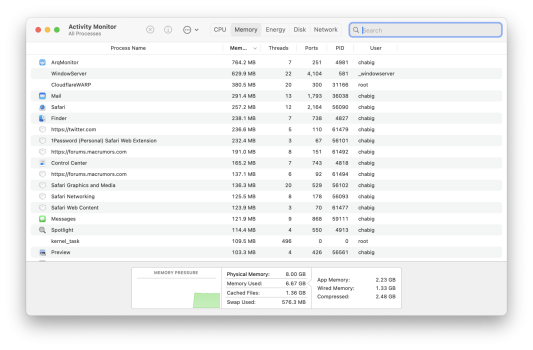I’m a dev and I compiled software on an 8GB 2018 i5 MBA.
...and I've "compiled software" on a 4GB Raspberry Pi. It's no longer the litmus test of a powerful personal computer. Outside of "professional" jobs like video/3D production or AI training, I'd say that web browsing was now the biggest resource drain, since every web page seems to "need" a ton of interpreted scripts and multiple automatically-playing videos and animations. Even if you deploy ad blockers etc. the good old days when site designers tried to shave every spare kilobyte off the images, or restrict videos to 12fps, so they would download on a 28k modem are long gone, in favour of retina-resolution images and websites with photographic backgrounds.
8GB was already the sensible minimum for "serious" work circa 2011 (MacBook Pros came with 4GB but, back then, could be easily upgraded). Since then, for one thing, we've gone from 110ppi screens to mostly 220ppi screens - a
4x increase in the size of bitmap/video files (and
that's ignoring things like HDR) - that's not just affecting the size of application icon files and downloaded images, but the off-screen bitmaps that many applications use for rendering.
We've also seen processors gaining more and more cores : cores process data, they don't chew the cud, so that data has to come from somewhere and go somewhere. That means
more memory. I wouldn't choose the industry rule of thumb of "4GB per core" as a hill to die on (probably true of specific server/multiuser workloads - but still an over-simplification) but the principle is there.
The M-series does have super-fast SSD access, which helps data throughput & makes virtual memory more efficient - but even fast SSD is
still an order of magnitude slower than RAM.
If your Mac is actively swapping then it is being slowed down by lack of RAM. Full stop - except to note that "actively swapping" refers to the page fault rate, not "swap used". Apple have helpfully removed "page fault rate" from Activity Monitor in the interests of dumbing-down, but it is presumably one of the factors behind "memory pressure".
Simply put, in 2024, 8GB of RAM (and a $200 premium to upgrade) is cutting corners for a $1600-$1800 "pro" computer - even if you just take the "pro" to mean "an improvement over entry level". You can cherry pick exceptions, but most
remotely comparable laptop PCs (such as Dell XPS or Lenovo Thinkbooks) in that price range now start at 16GB and/or offer cheaper upgrades (and, yes, its the same commodity LPDDR memory, just soldered to the board rather than the processor). You could make an argument for the base M1 Air or the $600 Mini, maybe, but even there its laughable that the
better models still only come with 8GB.
Or, to put it another way, since 2012 the default RAM size hasn't budged an inch (and the default SSD size has only improved slightly) while virtually every other specification has improved drastically. Faster processors process more data, and even the base M1/M2 are now fast processors that deserve a decent amount of RAM. There's no evidence from the rest of the PC market that RAM and SSD haven't seen the same sort of price/performance advance as the rest of technology - and although the way Apple
connects RAM and SSD to the processor is a bit different, the LPDDR5x RAM and flash memory they use is perfectly standard.


